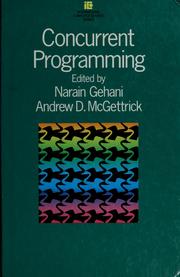| Listing 1 - 4 of 4 |
Sort by
|
Book
ISBN: 0262037661 9780262037662 Year: 2018 Publisher: Cambridge (Mass.): MIT Press,
Abstract | Keywords | Export | Availability | Bookmark
 Loading...
Loading...Choose an application
- Reference Manager
- EndNote
- RefWorks (Direct export to RefWorks)
Book
Year: 1992 Publisher: Paris: Eyrolles,
Abstract | Keywords | Export | Availability | Bookmark
 Loading...
Loading...Choose an application
- Reference Manager
- EndNote
- RefWorks (Direct export to RefWorks)
Resource Allocation --- mutual exclusion --- Parallelism --- synchronization --- Distributed Algorithms

ISBN: 0201174359 9780201174359 Year: 1988 Publisher: Wokingham
Abstract | Keywords | Export | Availability | Bookmark
 Loading...
Loading...Choose an application
- Reference Manager
- EndNote
- RefWorks (Direct export to RefWorks)
Programming --- Parallel programming (Computer science) --- Programmation parallèle (Informatique) --- 681.3*D1 --- Computer programming --- Parallel processing (Electronic computers) --- Programming techniques--See also {681.3*E} --- 681.3*D1 Programming techniques--See also {681.3*E} --- Programmation parallèle (Informatique) --- Concurrent Programming --- Distributed Algorithms --- Distributed
Book
ISBN: 3642381227 9783642381225 3642381235 Year: 2013 Publisher: Berlin, Heidelberg : Springer Berlin Heidelberg : Imprint: Springer,
Abstract | Keywords | Export | Availability | Bookmark
 Loading...
Loading...Choose an application
- Reference Manager
- EndNote
- RefWorks (Direct export to RefWorks)
Distributed computing is at the heart of many applications. It arises as soon as one has to solve a problem in terms of entities -- such as processes, peers, processors, nodes, or agents -- that individually have only a partial knowledge of the many input parameters associated with the problem. In particular each entity cooperating towards the common goal cannot have an instantaneous knowledge of the current state of the other entities. Whereas parallel computing is mainly concerned with 'efficiency', and real-time computing is mainly concerned with 'on-time computing', distributed computing is mainly concerned with 'mastering uncertainty' created by issues such as the multiplicity of control flows, asynchronous communication, unstable behaviors, mobility, and dynamicity. While some distributed algorithms consist of a few lines only, their behavior can be difficult to understand and their properties hard to state and prove. The aim of this book is to present in a comprehensive way the basic notions, concepts, and algorithms of distributed computing when the distributed entities cooperate by sending and receiving messages on top of an asynchronous network. The book is composed of seventeen chapters structured into six parts: distributed graph algorithms, in particular what makes them different from sequential or parallel algorithms; logical time and global states, the core of the book; mutual exclusion and resource allocation; high-level communication abstractions; distributed detection of properties; and distributed shared memory. The author establishes clear objectives per chapter and the content is supported throughout with illustrative examples, summaries, exercises, and annotated bibliographies. This book constitutes an introduction to distributed computing and is suitable for advanced undergraduate students or graduate students in computer science and computer engineering, graduate students in mathematics interested in distributed computing, and practitioners and engineers involved in the design and implementation of distributed applications. The reader should have a basic knowledge of algorithms and operating systems.
Distributed algorithms --- Electronic data processing --- Distributed processing --- Mathematics --- Computer science. --- Computer hardware. --- Computer communication systems. --- Computer programming. --- Computers. --- Computer Science. --- Theory of Computation. --- Computer Communication Networks. --- Programming Techniques. --- Computer Hardware. --- Automatic computers --- Automatic data processors --- Computer hardware --- Computing machines (Computers) --- Electronic brains --- Electronic calculating-machines --- Electronic computers --- Hardware, Computer --- Computer systems --- Cybernetics --- Machine theory --- Calculators --- Cyberspace --- Computers --- Electronic computer programming --- Electronic digital computers --- Programming (Electronic computers) --- Coding theory --- Communication systems, Computer --- Computer communication systems --- Data networks, Computer --- ECNs (Electronic communication networks) --- Electronic communication networks --- Networks, Computer --- Teleprocessing networks --- Data transmission systems --- Digital communications --- Electronic systems --- Information networks --- Telecommunication --- Cyberinfrastructure --- Network computers --- Informatics --- Science --- Programming --- Information theory. --- Communication theory --- Communication --- Distributed algorithms. --- Mathematics. --- Electronic data processing - Distributed processing - Mathematics
| Listing 1 - 4 of 4 |
Sort by
|

 Search
Search Feedback
Feedback About UniCat
About UniCat  Help
Help News
News